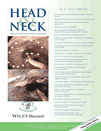Novel differential diagnostic method for superficial/deep tumor of the parotid gland using ultrasonography
Abstract
Background
The purpose of this study was to prepare the ultrasonographic diagnostic criteria on parotid tumors for preoperative differentiation of superficial and deep tumors.
Methods
We evaluated 154 patients with a benign parotid tumor who underwent surgery. The minimum thickness of normal parotid gland tissue between the parotideomasseteric fascia and tumor (minimum fascia–tumor distance [MFTD]) was measured on preoperative ultrasonography and compared among tumors at different locations, and the optimum cutoff value to differentiate a deep tumor was identified.
Results
The MFTD showed significant differences between superficial and deep tumors and between inferior pole and deep tumors. The sensitivity, specificity, and accuracy of an MFTD ≥3 mm for the differentiation of deep tumors were 85%, 91%, and 89%.
Conclusion
A tumor with an MFTD ≥3 mm on preoperative ultrasonography is very likely to be a deep tumor based on a new differentiation method for deep parotid tumors considering those present at other locations. Head Neck, 2013




